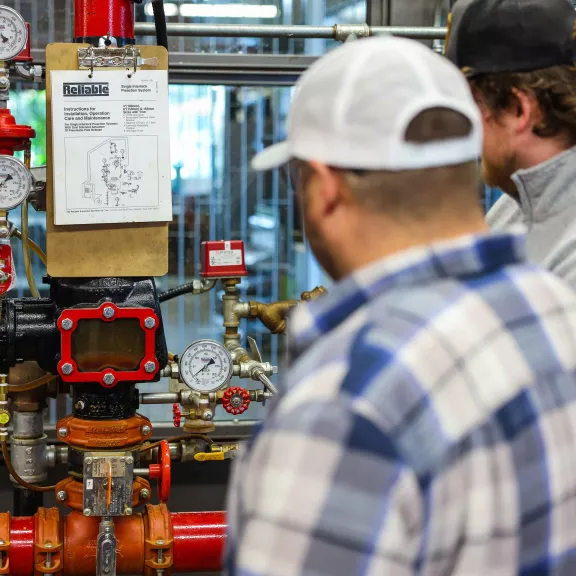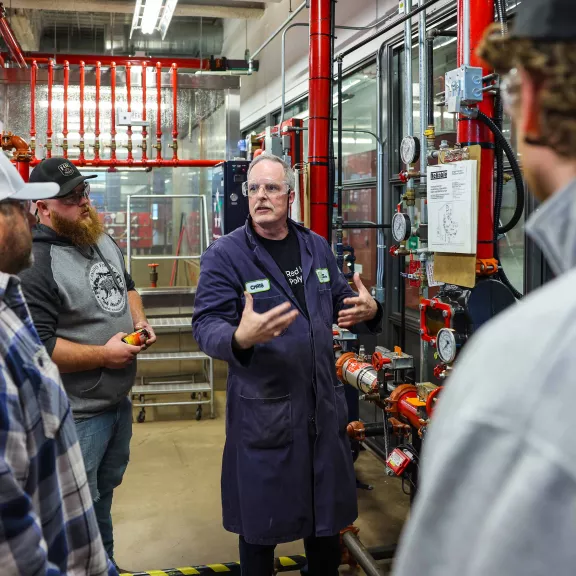
Sprinkler Systems Installer Apprenticeship
About the Sprinkler Systems Installer Apprenticeship
Make an impact in your community by starting a career as a Sprinkler Systems Installer and have a role in saving lives. This physically demanding job is an important part of the construction industry as it performs precise, meticulous, and important work on one of the most critical safety systems in commercial or industrial locations.
In this program, you will learn to fabricate, install, test, maintain, inspect and repair sprinkler systems in industrial operations, department stores, office buildings, hotels, schools, hospitals and residences. You will spend a lot of your technical training in shops to support and apply the theory you learn in class.
Sprinkler Systems Installers are generally employed in the construction industry. You will have the option to become Provincial Apprenticeship committee member, Local Apprenticeship committee member. You will also benefit from connections with NFPA community web forums.
Experienced Sprinkler Systems Installers may advance to supervisory positions or start their own businesses.
Take the skills you learn and challenge yourself. This trade has the opportunity for you to compete in the Provincial Skills Canada Competition, Skills Canada National Competition and WorldSkills Competition.
When you graduate, you’ll receive both a:
Journeyperson Certificate: This certificate not only acknowledges your expertise in your chosen trade but also grants you the legal authority to work in that trade.
Education Credential: This is a formal testament to your dedication and hard work. It confirms that you've successfully finished a Diploma in a -post-secondary study program and highlights the time and effort you've invested in mastering your trade or profession.
Work-integrated Learning
Apprenticeship is a unique form of post-secondary education that blends hands-on work experience with classroom learning. On average, you will spend 80 per cent of your apprenticeship on the job, practicing your trade or profession, and 20 per cent in the classroom or lab through structured learning at RDP.
Further Study
At the end of the final year of the program, you will also be eligible to earn a Red Seal Endorsement on your Journeyperson certificate upon successful completion of the Red Seal Exam. The Red Seal Endorsement allows Journeypersons to work anywhere in Canada without additional training.
If you have a valid Alberta Journeyman Certificate, you are eligible to receive a Blue Seal Achievement in business competencies after completing the necessary requirements.
Program Content
During this program you will spend eight weeks on campus every year, and a minimum of 1,600 hours on-the-job training annually for the first three years, and a minimum of 1800 hours of on-the-job training in the fourth year.
Completion of Classroom Training
Students must achieve a weighted average of 65% with no section under 50% in both the theory and practical components of the Classroom Training as well as achieving a minimum grade of 70% on the AIT Provincial Exam for each period of Classroom Training.
Requirements to complete a Journeyperson Certificate
The term of apprenticeship for a sprinkler systems installer is 4 years (four 12-month periods) including a minimum of 1600 hours of on-the-job training and 8 weeks of classroom instruction in each of the first three years, and a minimum of 1800 hours of on-the-job training in the fourth year.

Related Careers
Sprinkler Systems Installer
Journeyperson
Foreman
Red Seal endorsement available

Meet the Faculty
At Red Deer Polytechnic we are proud of our faculty members and staff who are experts in their disciplines and subject areas.
Admission Requirements
How to become an Apprentice:
Ensure you meet Apprenticeship and Industry Training (AIT) eligibility and entrance requirements for your desired skilled trade.
Apply for an Apprenticeship Education Program.
Register for classroom instruction.
Academic Requirements
Apprenticeship and Industry Training (AIT) entrance requirements recommended path:
ELA 30-2
Math 30-3
Physics 30 or Chem 30 or Science 30
Related CTS courses
OR
Minimum requirements:
ELA 20-2
Math 20-3
Science 10
OR
A pass on all five Canadian GED tests
OR
Successful completion of AIT’s entrance exam
Intake Details
Registration opens May 22, 2025
*Please note: registration can be completed online through the MyTradeSecrets (MTS) system. Assistance is available directly from your local Apprenticeship and Industry Training (AIT) office (hours may vary). Or from the RDP Office of the Registrar at 403-342-3100 or via email between 8:30am-4:30pm, Monday through Friday.
1st Period
September 2, 2025 - October 24, 2025
- On campus delivery
- On campus time requirements
- Monday-Friday | 8:30am-3:30pm
October 27, 2025 – December 19,2025
- On campus delivery
- On campus time requirements
- Monday-Friday | 8:30am-3:30pm
January 5, 2026 - February 27, 2026
- On campus delivery
- On campus time requirements
- Monday-Friday | 8:30am-3:30pm
March 2, 2026 - April 25, 24,2026
- On campus delivery
- On campus time requirements
- Monday-Friday | 8:30am-3:30pm
May 4, 2026 - June 26, 2026
- On campus delivery
- On campus time requirements
- Monday-Friday | 8:30am-3:30pm
2nd Period
January 5, 2026 - February 27, 2026
- On Campus Delivery
- On campus time requirements
- Monday-Friday | 8:30am-3:30pm
3rd Period
September 2, 2025 - October 24, 2025
- On Campus Delivery
- On campus time requirements
- Monday-Friday | 8:30am-3:30pm
March 2, 2026 - April 24, 2026
- On Campus Delivery
- On campus time requirements
- Monday-Friday | 8:30am-3:30pm
Program Cost
These costs are an estimate of tuition and fees based on the recommended course load per training period.
NOTE: Additional fees may apply.
For full fee information, view our Program Cost Estimates.
Financial Aid Options
Student life can be very expensive, and few individuals have enough money to pay up-front for their post-secondary education.